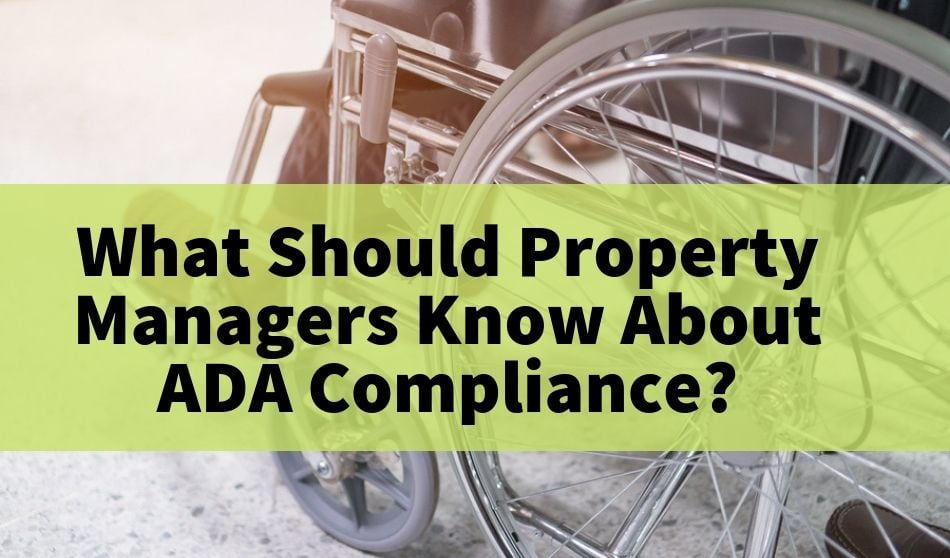
In 1990, ADA guidelines — rules to make it easier for disabled people to live and get around — were put in place.
Apartment and residential communities built both before and after this time are required to ensure disabled access to all public areas, including rental offices, event spaces, and public restrooms. An ADA apartment must also be easy to enter and exit, especially for those who use a wheelchair.
Who Falls Under ADA Protection?
The ADA protects those with a disability. But disability is a broad term that covers a wide range of conditions, both highly visible and entirely hidden. Property managers are unable to ask about the exact nature of a person’s disability, but it must be a physical or mental disorder that substantially limits life activities.
Some of the disabilities covered by the ADA include:
- Mental illness
- Visual impairment
- Mobility impairment
- Noncontagious diseases
Those with a disability, estimated to be around 12.8% of the American population in 2016, may have trouble caring for oneself or performing manual tasks. Ambulatory disabilities, which cause people to struggle with mobility, are the most common types of disabilities in the U.S., affecting more than 6.6% of the population. Other types of disorders cause issues with concentration, communication, and social interaction.
What Are Reasonable Accommodations?
A reasonable accommodation is a change to the rules, policies, practices or living environment that aids someone with a disability and does not create an undue hardship on the property manager. The goal is for tenants to experience the full benefits of living in the community.
One example of a reasonable accommodation is allowing someone who experiences seizures to have a service dog in a no-pet apartment community. If you have a laundry room that is strictly for tenants, a tenant who uses a wheelchair may ask for accommodation to allow a friend or family member inside.
If a tenant requests reasonable accommodation, the apartment manager can require verification of the disability. However, asking for further information about the extent or severity of the disability is prohibited. Once a request is made, an apartment complex has limited time to respond.
Who Is Financially Responsible for Modifications?
Landlords are typically responsible for the cost of reasonable accommodations, whether it be a designated accessible parking spot or adding a wheelchair ramp to the complex entrance. Most accommodations are free or low cost to implement.
When it comes to interior modifications made to an apartment, the costs fall on the tenant. Modifications could include adding railing to the bathroom or removing carpeting for allergy control. Renters are also required to restore the apartment to its original state if requested by the landlord. However, apartment managers and tenants can often negotiate to keep the apartment as-is.
What Are Common ADA Myths?
There are a lot of myths floating around about what ADA regulations are and what they mean. One of the most prolific is that ADA lawsuits are flooding courtrooms.
This myth may have caused some property managers to be wary of dealing with tenants with different abilities. But research shows that out of the millions of businesses, employers and entities that must comply with the ADA, only 650 lawsuits were filed over five years.
Another myth includes older or historic buildings as exempt from ADA guidelines. All buildings are required to make public spaces accessible to those with disabilities. However, buildings constructed or renovated after 1990 or 2010 face stricter regulations when it comes to design.
Another detrimental myth is that those who settle an ADA lawsuit cannot be sued again. If a violation is discovered, a person has the right to file suit to ask for modifications. Many states put rules in place to prevent multiple lawsuits, but it’s still best to learn how to improve your apartment complex’s ADA compliance.
How Can ADA Compliance Be Improved?
The first step toward improved compliance is to look up the guidelines provided by the ADA. The regulations followed are determined by the year your apartment complex was built.
General compliance ensures all indoor and outdoor routes, like sidewalks, ramps and elevators, are accessible. Doorways and entrances should have enough clearance for wheelchairs to maneuver. If you have a larger property, consider installing a chair lift — a seat that moves along a motorized rail that can help tenants with disabilities move around — or elevator. And provide handicap-only parking spaces near the entrance of the complex.
Have large-type copies of relevant paperwork available — including rental applications and leases — for those who request it. And provide guests with an easy way to communicate their needs, whether it be through email, a tip box or a dedicated tenant phone line.
ADA Compliance for Property Managers
ADA compliance doesn’t have to be complicated. Research the specific regulations for your building, avoid common misconceptions and determine how to make improvements. If a tenant makes a request based on a disability, determine if the request is reasonable, ask for verification — if necessary — and implement the change.